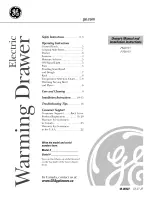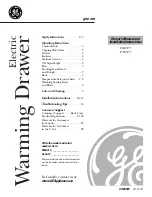
8
Suggested Heat Settings
Food Setting
Moisture
Setting
Proofi ng yeat dough
Moist
Bacon
3
Dry
Beef, Med - well done
2
Moist
Beef, Med rare
1
Moist
Bread, hard rolls
3
Dry
Bread, soft rolls, danish
2
Moist
Biscuits
2
Moist
Casseroles
2
Moist
Eggs
2
Moist
Fish, seafood (grilled)
2
Moist
Fried foods
3
Dry
Gravy, cream sauces
2
Moist
Operation
Ham
2
Moist
Pancakes
3
Moist
Pies, one crust
2
Moist
Pies, two crusts
2
Dry
Pizza
3
Dry
Pork
2
Moist
Potatoes, baked
3
Moist
Potatoes, mashed
2
Moist
Vegetables
2
Moist
Plates
1
Dry
Plate of Food
2
Moist
Moisture Selector
For
moist
heat, slide the moisture selector to the left to close the vents which captures the heat and moisture.
For
dry
heat, slide the moisture selector to the right to open the vents which allows the moist heat to escape.
Plug
Cable
Probe
Handles
Using the Meat Probe
The meat probe monitors the internal temperature of foods
placed in the warming drawer
- During any preset operating mode, the internal temperature of
the meat can be checked.
- Insert the probe end completely into the meat. It should not
touch the bone, fat, or gristle. Place meat in warming drawer.
- Before preheating and while the drawer is open, insert the plug
end into the meat probe jack located on the inside right upper
wall. NOTE: The meat probe option will not be selectable if not plugged into control.
- Press the “Time/Temp/Probe” toggle button until the display shows “Prb”. After 2 seconds,
the display will change to the probe temperature.
- At any time, the “Time/Temp/Probe” toggle button can be pressed to toggle between
time (if timer is set), drawer temperature, or meat probe temperature.
Meat
Probe Jack
Condensation
The warming drawer is supplied with a system which provides
a natural circulation of air. In most cases, this natural circulation
will eliminate any observed condensation. However, there will be
instances where condensation is observed. This is NOT a sign that
the unit is not working properly.
Condensation can occur depending on the following factors:
• Type of food being cooked
- Steam and condensation is a natural by product of
cooking any food with high water content, such as
frozen food, chicken, etc.
- Use a covered container, where practical, when cooking
to reduce the amount of condensation that forms.
• Length of cooking time
- If the unit is going to be used for prolonged periods of
time, then additional ventilation may be required.
- Do not leave food in the drawer to cool after it has been
cooked and has been switched off .
- To reduce condensation, ensure the drawer is well
heated before placing food in the drawer.
• Proper installation ventilation
- The drawer needs good ventilation within the installed
cabinets to perform per specifi cation.
• Type of cabinetry the oven is installed in
- Cabinets need to meet specifi c temperature
requirements.
• Ambient conditions in the kitchen including humidity and
temperature can increase the amount of condensation that
forms.






























